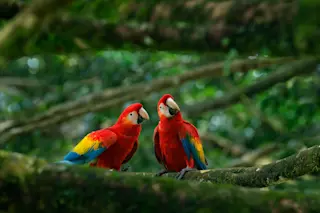(Credit: Ondrej Prosicky/shutterstock) Native Americans may have kept a breeding colony of scarlet macaws in the American Southwest starting more than 1,000 years ago, a new study finds. The birds were raised for their colorful plumage hundreds of miles from their native jungles. With their brilliant red, yellow and blue plumes, scarlet macaws are likely the best-known parrots of the New World. These birds normally range from South America to eastern coastal Mexico and Guatemala. Yet, over the years, archaeologists have unearthed hundreds of scarlet macaws skeletons in the American Southwest. These birds appear in the archaeological record of the area between 900 and 1200 AD, just as more complex societies were emerging in the region. These ancient civilizations include the Puebloan people at Chaco Canyon in present day New Mexico.
Scarlet macaws figured prominently in ancient cultures throughout the American Southwest. "Even now, ceremonial regalia in a lot of ...














